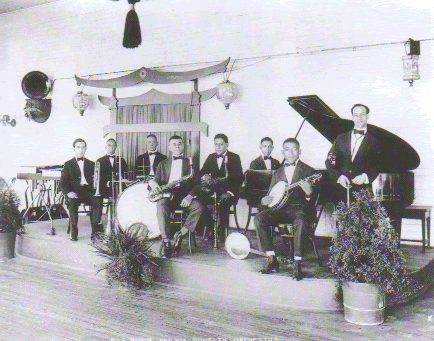| |
|
A.J. Piron
and His Novelty Orchestra
|
|
A.J. Piron
was unable to walk for years due to a crippling, childhood
accident. He focused on studying the violin, playing professionally,
and being a popular leader. Piron is most fondly remembered
for his band that played at Tranchina's Restaurant at Spanish
Fort. He was also a composer and co-formed, for jazz musicians,
a publishing company with Clarence Williams.
He was leader
of Piron's New Orleans Orchestra, which became one of the
great orchestras in New Orleans. Some famous musicians played
in it, including Lorenza Tio, Jr. and Louis Cottrell, Sr.
Old-timers remember the experience of hearing the melodies
of songs like "Purple Rose of Cairo" and "Dreamy
Blues" wafting over the waters of Lake Pontchartrain.
 |
A.J. Piron
and His Novelty Orchestra
Piron, far right:
|
|
| |
Al Rose said Armand was Creole, and told of taking another Creole
friend, Peter, to see Armand during his last days. Their greeting
in soft voices was "Evnin' Peter. You looking might prosperous
sir. The family fine?" Peter answered "Evenin' Arman.'
I hope you res'well this mawnin." It was a typical Creole
conversation.
From such an illustration, I
hope some of the beautiful relationships that existed in this
world of jazz are apparent.
Borrowed
from:
"Jazz New Orleans Style"
By Bobby Potts |
The Personel:
Charles Bocage-Banjo ...........Peter Bocage-Trumpet
Louis Cottrelle-Drums ............Steve Lewis-Piano
Armand J. Piron-Violin............. Charles Seguirre-Tuba
Lorenzo Tio, Jr.-Clarinet,....... Tenor Saxophone
Louis Warnecke-Alto Saxophone
Source
The BigBands Database Plus thanks Mr. Verne Buland for this entry on Armand Piron.
| More.... Wikipedia.com |
Piron was born to what was then called a Creole of color family in downtown New Orleans. From his childhood, he had to use a crutch to walk. He began playing violin professionally in about 1904 and, by 1912, was leading the Olympia Orchestra (which included Bunk Johnson, Big Eye Louis Nelson Delisle, and Clarence Williams).
In 1915, Piron and Williams together started the Piron and Williams Publishing Company, and in their first year of business published Piron's composition “I Wish That I Could Shimmy Like My Sister Kate”, which became his biggest hit.
After touring briefly with W.C. Handy in 1917, he started an orchestra under his own name, which soon included such notables as Lorenzo Tio and Steve Lewis. Piron's New Orleans Orchestra quickly became the best paid African American band in New Orleans, for Piron landed regular jobs at both the Spanish Fort amusement park and the exclusive white New Orleans Country Club.
In 1923, Piron took his band to New York City as part of his ambition to make the group nationally known. He succeeded in making a hit there, landing a residency at the Roseland Ballroom, and making recordings for three different companies.
The influence of Piron's band on the New York scene can be heard in the records of other New York bands of that time, such as Fletcher Henderson's (although Piron's influence on New York music would be eclipsed a year later when Louis Armstrong arrived in the city). In early 1924, some of Piron's band members were finding the cold northern winter and unfamiliar food and culture objectionable. Piron put the matter to a vote and, to Piron's frustration, the majority of the band voted to return home.
Back in New Orleans, he again lined up good jobs, returning to the Country Club, playing at Tranchina's Restaurant and on the excursion steamships Capital and President into the 1930s; in about 1935, he decided to dramatically change the sound of his orchestra to swing, in line with popular taste.
Piron died on February 17, 1943.
|
A bit of Personel life of Armand J. Piron |
Armand John Piron’s home --
1818 Columbus Street
|
By: By Lili LeGardeur
|
Posted: Tuesday, October 7, 2008 11:13 am..The Louisiana Weekly
|
In 1912, North Claiborne Avenue was a stately tree-lined thoroughfare lined with homes and businesses, Armand John Piron was a newlywed, and the violin was an important instrument in jazz.
It’s necessary to imagine all these things to conjure the life that Piron, one of New Orleans’ most prominent bandleaders, music publishers and composers, lived during his residency at 1818 Columbus St. The 1870 three-bay shotgun house, located just a few blocks from North Claiborne Ave., was a rental home then in a neighborhood favored by people of Creole ancestry.
Piron himself was a Creole of color, born August 16, 1888 as the youngest son of Octave Piron and Marie Jeanne Zeringue. He spent most of his early life —from 1896 to 1911—with his family in a house at 1523-25 Columbus St. After his 1912 marriage to neighbor and sweetheart Oxana McKenna, Piron moved just three blocks away to 1818 Columbus.
The four-room house they rented from Mrs. Rosa Tricou for $15 a month might have been spacious for two. As was the custom in those days, however, the couple moved family as well as a business in with them. Armand and Oxana Piron lived here from 1912-1915 with Armand’s mother and father, his brother Theodule and a male cousin. During those years, Piron gave music lessons in the front room. In addition to teaching music and giving concerts, Piron worked as a barber at 1476 N. Claiborne, partnering with violinist Paul Dominguez in a small storefront barber shop there.
Piron would have garnered respect in his neighborhood as a performer and “professor” of music. In 1918, though, he established a band that would make him something of a local celebrity. Known as Piron’s New Orleans Orchestra, the “sweet society” band played favorites and original compositions at Tranchina’s and the Southern Yacht Club on the lakefront and The Pythian Roof Garden in town.
The music they played was bright and danceable, without any of the raucous lyrics or brassy, unbridled solos that characterized players like Buddy Bolden and Frankie Dusen. In fact, photos of the nine-piece ensemble smack of formality and rectitude. Unlike many bands of the period who would clown for the camera, Piron and his band members appear all in tuxedos and hold their instruments proudly. A photo of Piron and Williams’ short-lived vaudeville act from the early teens is a rare exception. Which is not to say that the orchestra didn’t excel at entertaining; singers Lela Bolden and Esther Bigeou were a fixture with the band, and pianist Steve Lewis was famous for engaging the audience.
Apart from his prominence as a bandleader, Piron gained fame in another area, as co-owner of the first African-American music publishing house in New Orleans. In 1915, Piron joined with pianist-composer Clarence Williams to form Piron & Williams Music Company, which published many of Piron’s original compositions. The song “I Wish I Could Shimmy Like My Sister Kate” was published under Piron’s name, though he later said it was an old tune that numerous musicians played with different titles. Other Piron originals published by Piron & Williams include “Mama’s Gone Goodbye” and “Kiss Me Sweet,” and “The Purple Rose of Cairo,” a Piron composition that the Piron Orchestra adopted as its theme song.
Piron & Williams was located at 1315 Tulane Ave., between Liberty and Franklin Streets. Like many sites associated with early New Orleans jazz, that building is gone now, replaced by the offices of a modern medical complex. Piron and Williams continued in business together until at least 1919, after which Piron is thought to have moved his own publishing concern into the Knights of Pythias building on the corner of Loyola Ave. and Gravier St.
Piron’s father was a musician and teacher as well as a shoemaker. He gave his sons Milford, Albert and Armand professional music training at an early age. Milford played the cornet, and Albert and Armand played violin. The three probably played in a small orchestra with brothers Vic and Nelson Gaspard. By 1904, Armand was performing with Joseph Bloom’s 22-piece Philharmonic Orchestra along with Professor Henry Nickerson and Charles Elgar.
In 1910, the young musicians formed the Peerless Orchestra with John Vigne on drums, Charles McCurdy on clarinet, Coochie Martin on guitar, Vic Gaspard on trombone, Nelson Gaspard on double bass and Andrew Kimball on cornet. When Freddie Keppard left the Olympia Orchestra in 1912 to join another band in California, Piron took over leadership of that group and stayed with it until 1914.
This was the band that played popular student dances at the Tulane University Gymnasium in 1914. According to Edmond “Doc” Souchon, the group under Piron’s leadership included Sidney Bechet on cornet, Joe “King” Oliver on cornet, Zue Robertson on trombone and Louis Keppard on guitar. “Piron was fast becoming perhaps the most successful Creole Orchestra leader in New Orleans, working all the top hotels, country clubs and society dances,” Souchon later recalled.
The Piron Orchestra featured Lorenzo Tio, Jr. as its star clarinetist. The personnel shifted over the years, but at various times it included Louis Warnecke on saxophone, Steve Lewis on piano, Louis Cottrell on drums, Peter Bocage on trumpet and his brother Charles Bocage on banjo. Johnny St. Cyr also played banjo with the group briefly.
The group played the country clubs and society dances, and Piron’s need for “day job” as a barber quickly faded. The Piron Orchestra traveled to New York twice in 1923, first for an engagement at The Cotton Club and later to open the Roseland Ballroom on 151st St. It was in New York that they first recorded. Tragically, the master cylinder for recording of ‘The Purple Rose of Cairo,” the orchestra’s theme song, has disappeared; only the sheet music survives.
Piron’s Orchestra continued until 1928, after which the bandleader hired several members of George Augustin’s Moonlight Serenaders and began playing aboard steamers on the Mississippi River. Various groups under Piron’s leadership played on board the S.S. Pelican, the S.S. Capitol and the S.S. President between 1929 and 1932. Piron died in Charity Hospital in 1943.
Music lovers can actually enjoy the sound of Piron’s New Orleans Orchestra on a recording of the band’s 1923 New York session available from Azure. In addition, The New Orleans Ragtime Orchestra and The New Leviathan Oriental Foxtrot Orchestra frequently play Piron compositions in the spirit of the original.
The house at 1818 Columbus, meanwhile, had already become too small for the growing Piron family by 1915. They moved to larger quarters at 1754 N. Derbigny Street two years after the couple’s first child was born. The house on Columbus St. bears a plaque from the Preservation Resource Center noting Piron’s residence there. Homeowner Marie Henry, who purchased and restored the building in 1988, said that she sometimes senses the presence of the music professor in the front room where he once met his students for private lessons.◊
Source ...
The LouisianaWeekly Publication
|
|
|
|
|

